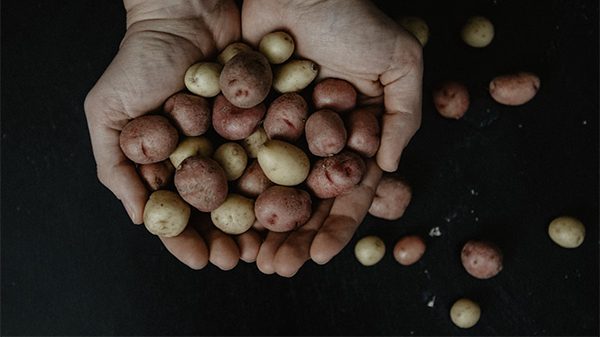The potato plant is a Jekyll and Hyde: the part that grows underground is a major food staple, while the part that is aboveground is poisonous. Its vines and greens contain the toxic substance solanine.
Fortunately, recent claims connecting potatoes (the underground kind) and elevated risk of heart disease are apparently invalid. A research team led by Iaonna Yiannakou discovered no connection between potato consumption and hypertension, elevated blood glucose (type 2 diabetes), or elevated triglycerides. Potato consumption is not associated with cardiometabolic health outcomes in Framingham Offspring Study adults – The Alliance for Potato Research & Education (apre.org)


To go back aboveground, under certain circumstances some potato plants will produce berries that resemble small cherry tomatoes. These berries are also inedible, but they hold the key to the crop’s future.
Curzio Caravati, a Swiss immigrant who raises crops (mostly potatoes) on a small plot in Kenosha, WI, has started the nucleus of a worldwide potato breeding initiative. This Modern Farmer Wants You to Grow a New Potato Strain – Modern Farmer
In 2007, Caravati launched the Kenosha Potato Project (KPP). At first, it was merely a Facebook page to talk about growing potatoes, but it has grown into a worldwide network centered on the little-known potato berry.
Potatoes, like most food crops, are grown on a large scale in single varieties. Seed potatoes are simply parts or eyes of potatoes that are replanted, making them genetically identical to their parents.
This homogeneity makes the plant vulnerable to pests and disease. The disastrous Irish potato famine of the late 1840s is the most famous example.
But the potato berry contains a solution. It offers a panoply of genetic alternatives. Unlike many other species (including us humans), it’s tetraploid rather than diploid: it has four sets of genes rather than two.
The extra set of chromosomes magnifies the possibilities of diversity. The true potato seed (TPS) could lead to the creation of many new potato varieties.
It already has. KPP member Rick Machado used TPS to develop a heat- and drought-resistant potato in Southern California, which he has named “Isla.”
Rhode Island KPP member Nathan Pierce, working with his daughter’s high-school greenhouse club, has developed a late-season variety that can be harvested in the fall. It can also tolerate pest pressure from Colorado potato beetles.
Growers who are interested in the project can join “TPS Trains.” Beginning members can sign up to receive TPS seed samples; advanced members also receive samples but must contribute samples from their own gardens as well.
KPP has managed to connect growers from 120 countries.
Yes, monoculture is here to stay for the foreseeable future—for potatoes as well as most other crops.
But whatever climate and market needs may dictate about the crop’s future, one thing won’t change: the need for diversity to keep up with whatever reality demands.



